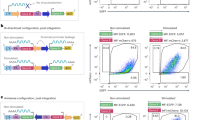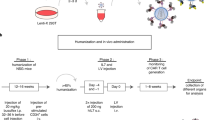Summary
Genetic modification of peripheral blood T lymphocytes (PBL) or hematopoietic stem cells (HSC) has been shown to be promising in the treatment of cancer (Nat Rev Cancer 3:35–45, 2003), transplant complications (Curr Opin Hematol 5:478–482, 1998), viral infections (Science 285:546–551, 1999), and immunodeficiencies (Nat Rev Immunol 2:615–621, 2002). There are also significant implications for the study of T cell biology (J Exp Med 191:2031–2037, 2000). Currently, there are three types of vectors that are commonly used for introducing genes into human primary T cells: oncoretroviral vectors, lentiviral vectors, and naked DNA. Oncoretroviral vectors transduce and integrate only in dividing cells. However, it has been shown that extended ex vivo culture, required by oncoretroviral-mediated gene transfer, may alter the biologic properties of T cells (Nat Med 4:775–780, 1998; Int Immunol 9:1073– 1083, 1997; Hum Gene Ther 11:1151–1164, 2001; Blood 15:1165–1173, 2002; Proc Natl Acad Sci U S A, 1994). HIV-1-derived lentiviral vectors have been shown to transduce a variety of slowly dividing or nondividing cells, including unstimulated T lymphocytes (Blood 96:1309–1316, 2000; Gene Ther 7:596–604, 2000; Blood 101:2167–2174, 2002; Hum Gene Ther 14:1089–1105, 2003). However, achieving effective gene transfer and expression using lentivirus vectors can be complex, and there is at least a perceived risk associated with clinical application of a vector based on a human pathogen (i.e., HIV-1). Recently it has been found that oncoretroviral and lentiviral vectors show a preference for integration into regulatory sequences and active genes, respectively (Cell 110:521–529, 2002; Science 300:1749–1751, 2003). Additionally, insertional mutagenesis has become a serious concern, after several patients treated with an oncoretroviral vector for X-linked SCID developed a leukemia-like syndrome associated with activation of the LMO2 oncogene (Science 302:415–419, 2003). Naked DNA-based genetic engineering of human T lymphocytes also requires T cells to be activated prior to gene transfer (Mol Ther 1:49–55, 2000; Blood 101:1637–1644, 2003; Blood 107:2643–2652, 2006). In addition, random integration by electroporation is of low efficiency. We have recently reported that the Sleeping Beauty transposon system can efficiently mediate stable transgene expression in human primary T cells without prior T cell activation (Blood 107:483–491, 2006). This chapter describes methodology for the introduction of SB transposons into human T cell cultures with subsequent integration and stable long-term expression at noticeably high efficiency for a nonviral gene transfer system.
Access this chapter
Tax calculation will be finalised at checkout
Purchases are for personal use only
Similar content being viewed by others
References
Ivics, Z., Hackett, P. B., Plasterk, R. H., Izsvak, Z. (1997) Molecular reconstruction of Sleeping Beauty, a Tc1-like transposon from fish, and its transposition in human cells. Cell 91, 501 –510
Izsvak, Z., Ivics, Z. (2004) Sleeping Beauty transposon: biology and applications for molecular therapy. Mol Ther 9, 147 –156
Geurts, A. M., Yang, Y., Clark, K. J., et al. (2003) Gene transfer into genomes of human cells by the Sleeping Beauty transposon system. Mol Ther 8, 108 –117
Yant, S. R., Wu, X., Huang, Y., et al. (2005) High-resolution genome-wide mapping of transposon integration in mammals. Mol Cell Biol 25, 2085 –2094
Yant, S. R., Meuse, L., Chiu, W., Ivics, Z., Izsvak, Z., Kay, M. A. (2000) Somatic integration and long-term transgene expression in normal and haemophilic mice using a DNA transposon system. Nat Genet 25, 35 –41
Belur, L. B., Frandsen, J. L., Dupuy, A. J., et al. (2003) Gene insertion and long-term expression in lung mediated by the Sleeping Beauty transposon system. Mol Ther 8, 501 –507
Luo, G., Ivics, Z., Izsvak, Z., Bradley, A. (1998) Chromosomal transposition of a Tc1/mariner-like element in mouse embryonic stem cells. Proc Natl Acad Sci USA 95, 10769 –10773
Dupuy, A. J., Clark, K., Carlson, C. M., et al. (2002) Mammalian germ-line transgenesis by transposition. Proc Natl Acad Sci USA 99, 4495 –4499
Collier, L. S., Carlson, C. M., Ravimohan, S., Dupuy, A. J., Largaespada, D. A. (2005) Cancer gene discovery in solid tumours using transposon-based somatic mutagenesis in the mouse. Nature 436, 272 –276
Dupuy, A. J., Akagi, K., Largaespada, D. A., Copeland, N. G., Jenkins, N. A. (2005) Mammalian mutagenesis using a highly mobile somatic Sleeping Beauty transposon system. Nature 436, 221 –226
Keng, V. W., Yae, K., Hayakawa, T., Mizuno, S., Uno, Y., Yusa, K., Kokubu, C., Kinoshita, T., Akagi, K., Jenkins, N. A., Copeland, N. G., Horie, K., Takeda, J. (2005) Region-specific saturation germline mutagenesis in mice using the Sleeping Beauty transposon system. Nat Methods 2, 763 –769
Kitada, K., Ishishita, S., Tosaka, K., Takahashi, R., Ueda, M., Keng, V. W., Horie, K., Takeda, J. (2007) Transposon-tagged mutagenesis in the rat. Nat Methods 4, 131 –133
Huang, X., Wilber, A. C., Bao, L., Tuong, D., Tolar, J., Orchard, P., et al., (2006) Stable gene transfer and expression in human primary T cells by the Sleeping Beauty transposon system. Blood 107, 483 –491
Akagi, Y., Isaka, Y., Akagi, A., et al. (1999). Transcriptional activation of a hybrid promoter composed of cytomegalovirus enhancer and beta-actin/beta-globin gene in glomeru-lar epithelial cells in vivo. Kidney Int 1999 51, 1265 –1269
Amendola, M., Venneri, M. A., Biffi, A., Vigna, E., Naldini, L. (2004) Coordinate dual-gene transgenesis by lentiviral vectors carrying synthetic bidirectional promoters. Nat Biotechnol 23, 108 –116
Levine, B. L., Bernstein, W. B., Aronson, N. E., et al. (2002) Adoptive transfer of cos-timulated CD4+ T cells induces expansion of peripheral T cells and decreased CCR5 expression in HIV infection. Nat Med 8, 47 –53
Riddell, S. R., Greenberg, P. D. (1990) The use of anti-CD3 and anti-CD28 monoclonal antibodies to clone and expand human antigen-specific T cells. J Immunol Methods 128, 189 –201
Sambrook, J., Russell, D. W. (2001) Molecular cloning: a laboratory manual. 3rd Edition. New York, NY : Cold Spring Harbor Laboratory Press
Hirt, B. (1967) Selective extraction of poly-oma DNA from infected mouse cell cultures. J Mol Biol 26, 365 –369
Acknowledgments
This work was supported by a Grant-in-Aid of Research, Artistry and Scholarship from the Graduate School, University of Minnesota, the Minnesota Medical Foundation, the Children's Cancer Research Fund, the Alliance for Cancer Gene Therapy Young Investigator Award, the G&P Foundation for Cancer Research, the Sidney Kimmel Foundation for Cancer Research Kimmel Scholar Award, and the National Blood Foundation. X.Z. is the recipient of an American Society of Hematology Junior Faculty Scholar Award.
Author information
Authors and Affiliations
Editor information
Editors and Affiliations
Rights and permissions
Copyright information
© 2009 Humana Press
About this protocol
Cite this protocol
Huang, X., Wilber, A., McIvor, R.S., Zhou, X. (2009). DNA Transposons for Modification of Human Primary T Lymphocytes. In: Baum, C. (eds) Genetic Modification of Hematopoietic Stem Cells. Methods In Molecular Biology™, vol 506. Humana Press. https://doi.org/10.1007/978-1-59745-409-4_9
Download citation
DOI: https://doi.org/10.1007/978-1-59745-409-4_9
Publisher Name: Humana Press
Print ISBN: 978-1-58829-980-2
Online ISBN: 978-1-59745-409-4
eBook Packages: Springer Protocols




